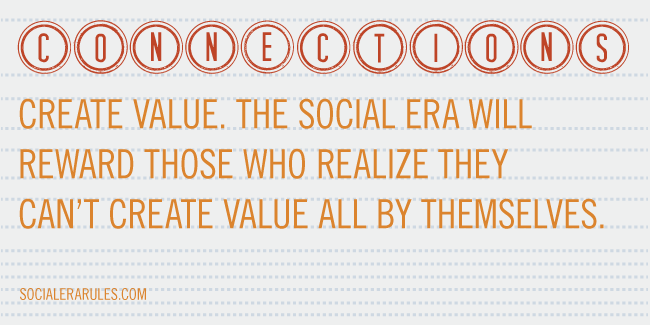
The 2 Secrets to Success for Social Media in Your Church
It’s getting hard to keep up with all the different social tools that are flying at us every day. We constantly hear things like:
“If you’re not on Pinterest you’re in big trouble.”
or
“Blogging is dead.”
It seems like people are putting a lot of effort into trying to figure out which tools they should use, and how they should use them. What’s the best way to deal with all of this us? I’ve been repeatedly hit in the face with the answer to this recently from my network, which teaches me a lot.
So here is the secret to social success:
Connect with people.
Simple, isn’t it. It doesn’t matter what tools you use – and if you spend too much time worrying about tools, you’ll forget to use them to do the one thing that matters – connecting.
Connecting Ideas is the Fundamental Creative Act in Innovation. You have to connect ideas to ideas to innovate, and you have to connect people to your ideas to get them to spread. It’s all about connection.
Earlier, I told you about the best social media strategy of all time:
Do awesome work.
That takes care of the connecting ideas to ideas part. Then, to get them to spread, you need to connect the ideas to people. And that means that you have to connect with people – that is the core purpose of all of these social tools.
Connections create value – that is the core message of Nilofer Merchant in her book 11 Rules for Creating Value in the #SocialEra. Here is one of my favourite quotes from the book:
We want innovation, but without experiencing failure. We want to embrace the new, but without risk. We want to act fast and fluid, but to maintain tight controls. We want to empower everyone, but retain decision rights for ourselves. We want to experiment, but we also want predictability. We want to be flexible to customer input, but remain ruthlessly efficient. We want to adapt, but we fear the death of familiarity.
This is why it’s hard to go from being an 800-pound gorilla to a herd of nimble gazelles; an organization goes from being a centralized institution that competes through overpowering strength and scale to a set of relationships or interrelationships. Gazelles thrive and win by how they share power with one another. And, as a result, they can act fast, fluid, and flexible. For organizations, this is key to winning in the marketplace.
As organisations, we win through connections. The same is true for people.
Here is Shane Mac from his book Stop With the BS:
All these apps, gadgets, buildings—everything for that matter—they don’t make me smile and think about how much I love what I do. The people I know do. It is the people and my relationships with them that really matter. Done. Simple as that. All we have in life are relationships, so we better start spending more time building new ones and rebuilding old ones. Build bridges, Re-build bridges, never Burn Bridges.
It’s the relationships that matter. Hugh MacLeod nails it in his latest book Freedom is Blogging in Your Underwear:
…all the internet is, as Doc Searls said, is a bunch of protocols that “allow us to get along.” Protocols allow us to talk to each other. The stuff in the middle, the stuff that separates us, the stuff that directly makes use of these protocols – hosting companies, web sites, blogging platforms, microblogging platforms, etc. – matter far less.
You’re on one end of the wire. Just think about who’s on the other end of the wire, and what you can do for them. Worry less about the wire. Worry less about the shiny objects in the middle.
Just worry about MAKING your own stuff, and the rest of the internet will look after itself.
So there is your two-step guide to social success.
Do awesome work.
and
Connect with people.
The problem is that while these steps might sound simple, they’re not. They take a lot of effort. That’s what makes the shiny new objects so seductive – they look like shortcuts.
Unfortunately, there are no shortcuts. That’s why it’s still remarkable when you do awesome work and connect with people.
I know that I still have a long way to go myself. But now that we’ve connected, maybe we can do some of this awesome work together.

Tags: Awareness, Intentionality, Social Media, Tim Kastelle













